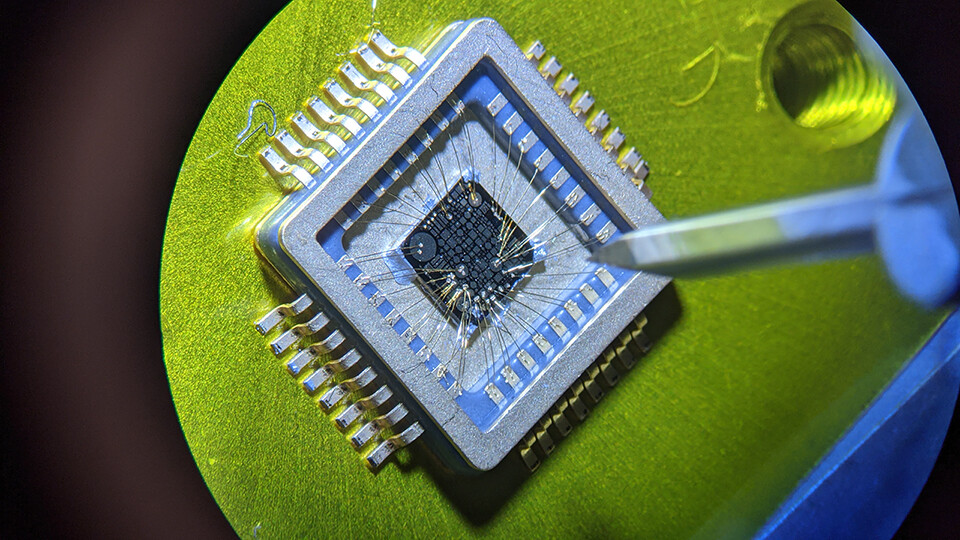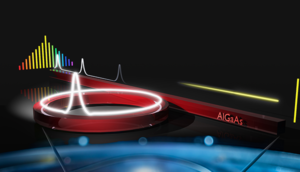NANO BLOG
February 8, 2022 – High-power diamond diodes tested with electronic noise

Characterizing defects in diamond devices destined for high-power electronics
Artificially grown diamonds are promising semiconductor materials. Their large energy gap, thermal conductivity, carrier mobility, and other properties make diamonds promising for electronic applications as ultrawide bandgap semiconductors, or UWBGs. However, diamond growth and device fabrication procedures can create defects, inhibiting their function as diodes.
To better assess diamonds for high-power electronics, Ghosh et al. used electronic noise to characterize diamond diode defects. Using grown diamonds, the authors measured low-frequency fluctuations in electrical currents sent through the diamond diodes.
“The measurement of electronic current fluctuations, or electronic noise, can be used to assess the quality of electronic materials and reliability of devices made from such materials,” said co-author Alexander Balandin. “The noise often originates in the non-ideal components or the non-ideal currents of a device. The increase in the noise level can be related to the device failure.”
The results showed the diodes with high and low concentrations of defects had different noise spectra. Additionally, the noise’s dependence on current density could be used to test the quality of the diode.
The authors plan to use the results to create quantitative models that can assess high-power electronics made from diamond and other UWBG semiconductor materials.
“The need for higher power electronics is apparent as we move towards an electrified economy and more energy efficient, interconnected society,” said co-author Robert Nemanich. “The knowledge gained by the ULTRA Center will provide the necessary scientific basis and a co-design ecosystem for a new power electronics economy with ultra-high voltage and current capabilities for highly efficient energy conversion and efficient thermal transport.”
Source: “Excess noise in high-current diamond diodes,” by Subhajit Ghosh, Harshad Surdi, Fariborz Kargar, Franz A. Koeck, Sergey Rumyantsev, Stephen Goodnick, Robert Nemanich, and Alexander A. Balandin, Applied Physics Letters (2022). The article can be accessed at https://doi.org/10.1063/5.0083383.
This paper is part of the Wide- and Ultrawide-Bandgap Electronic Semiconductor Devices Collection, learn more here, published by AIP Publishing.
National Nanotechnology Day (USA)
National Nanotechnology Day (USA)
Event Date: October 09, 2021
National Nanotechnology Day is an annual celebration featuring a series of community-led events and activities on or around October 9 to help raise awareness of nanotechnology, how it is currently used in products that enrich our daily lives, and the challenges and opportunities it holds for the future. This date, 10/9, pays homage to the nanometer scale, 10–9 meters.
Planning for various events and activities is underway at schools, universities, and various organizations around the country. Whether at home or outside, there are so many ways to explore advances in nanotechnology and how it is impacting our everyday lives!
See National Nanotechnology Day | National Nanotechnology Initiative for details.
February 16, 2021 — European Commission GreEnergy Project: nano solar energy harvesting
GreEnergy is a new project funded by the European Commission through the Horizon 2020 Programme aimed at developing optical nano-antennas as cost-effective solar energy harvester for a greener future
Most energy sources we use today have low efficiency, rely on non-renewable resources and cause severe damage to our planet by contributing to global warming. GreEnergy envisions the use of the cleanest energy source available: the sun. The sun is the world’s most powerful and abundant energy resource, and offers a nearly unlimited supply of energy to our planet. However, according to the Joint Research Centre (JRC), current solar photovoltaics (PV) produce roughly 4% of the world’s electricity, due to their low efficiency and relatively high costs.
GreEnergy’s ambition is to define a new paradigm in the field of solar energy harvesting, by prototyping a self-powering system based on optical nano-antennas which can harvest solar energy, rectify the AC signal and use it to charge a micro-supercapacitor. The targeted overall efficiency of the demonstrators is around 20-40%, which is competitive with respect to the state of the art.
Coordinated by Chalmers University of Technology, GreEnergy is a four-year interdisciplinary project that builds on the expertise of four top-level universities, one research centre and three specialized SMEs coming from 6 different countries, including Chalmers University of Technology (Sweden), Aalto University (Finland), AMO GmbH and IHP – Innovations For High Performance Microelectronics (Germany), NOGAH PHOTONICS Ltd (Israel), SCIPROM Sàrl (Switzerland), Università Politecnica delle Marche and Università di Udine (Italy).
“With GreEnergy we want to demonstrate that it is possible to harvest solar energy more efficiently and at lower cost than what is currently done with photovoltaic cells”, says the project coordinator Prof. Per Lundgren, from Chalmers University of Technology. “It is a real challenge to rectify electromagnetic waves at optical frequencies into a DC current for energy storage and management. This is something we intend to achieve with the coordinated design of the antenna, the rectifier and of the energy storage device for optimal integration. Such an integrated technology has no precedents and will represent a fundamental change in the way that solar energy can be harvested.”
For more info on GreEnergy: visit the GreEnergy website at https://www.greenergy-project.eu
October 09, 2020 – Thermal MagIC: New NIST Project to Build Nano-Thermometers Could Revolutionize Temperature Imaging
Cheaper refrigerators? Stronger hip implants? A better understanding of human disease? All of these could be possible and more, someday, thanks to an ambitious new project underway at the National Institute of Standards and Technology (NIST).
NIST researchers are in the early stages of a massive undertaking to design and build a fleet of tiny ultra-sensitive thermometers. If they succeed, their system will be the first to make real-time measurements of temperature on the microscopic scale in an opaque 3D volume — which could include medical implants, refrigerators, and even the human body.
The project is called Thermal Magnetic Imaging and Control (Thermal MagIC), and the researchers say it could revolutionize temperature measurements in many fields: biology, medicine, chemical synthesis, refrigeration, the automotive industry, plastic production — “pretty much anywhere temperature plays a critical role,” said NIST physicist Cindi Dennis. “And that’s everywhere.”
Measuring and controlling temperature in 3D is highly desirable for medical diagnostics, precision manufacturing, and much more. However, there is currently no way to measure 3D temperature inside these kinds of systems. NIST researchers are working on a solution using tiny nanoscale thermometers. Credit: Sean Kelley/NIST. Music: Blue Dot Sessions.The NIST team has now finished building its customized laboratory spaces for this unique project and has begun the first major phase of the experiment.
Thermal MagIC will work by using nanometer-sized objects whose magnetic signals change with temperature. The objects would be incorporated into the liquids or solids being studied — the melted plastic that might be used as part of an artificial joint replacement, or the liquid coolant being recirculated through a refrigerator. A remote sensing system would then pick up these magnetic signals, meaning the system being studied would be free from wires or other bulky external objects.
The final product could make temperature measurements that are 10 times more precise than state-of-the-art techniques, acquired in one-tenth the time in a volume 10,000 times smaller. This equates to measurements accurate to within 25 millikelvin (thousandths of a kelvin) in as little as a tenth of a second, in a volume just a hundred micrometers (millionths of a meter) on a side. The measurements would be “traceable” to the International System of Units (SI); in other words, its readings could be accurately related to the fundamental definition of the kelvin, the world’s basic unit of temperature.
The system aims to measure temperatures over the range from 200 to 400 kelvin (K), which is about -99 to 260 degrees Fahrenheit (F). This would cover most potential applications — at least the ones the Thermal MagIC team envisions will be possible within the next 5 years. Dennis and her colleagues see potential for a much larger temperature range, stretching from 4 K-600 K, which would encompass everything from supercooled superconductors to molten lead. But that is not a part of current development plans.
“This is a big enough sea change that we expect that if we can develop it — and we have confidence that we can — other people will take it and really run with it and do things that we currently can’t imagine,” Dennis said.
Potential applications are mostly in research and development, but Dennis said the increase in knowledge would likely trickle down to a variety of products, possibly including 3D printers, refrigerators, and medicines.
June 22, 2020 – Comb on a Chip: New Design for ‘Optical Ruler’
National Institute of Standards and Technology (NIST)
June 22, 2020
 Just as a meter stick with hundreds of tick marks can be used to measure distances with great precision, a device known as a laser frequency comb, with its hundreds of evenly spaced, sharply defined frequencies, can be used to measure the colors of light waves with great precision.
Just as a meter stick with hundreds of tick marks can be used to measure distances with great precision, a device known as a laser frequency comb, with its hundreds of evenly spaced, sharply defined frequencies, can be used to measure the colors of light waves with great precision.
Small enough to fit on a chip, miniature versions of these combs — so named because their set of uniformly spaced frequencies resembles the teeth of a comb — are making possible a new generation of atomic clocks, a great increase in the number of signals traveling through optical fibers, and the ability to discern tiny frequency shifts in starlight that hint at the presence of unseen planets. The newest version of these chip-based “microcombs,” created by researchers at the National Institute of Standards and Technology (NIST) and the University of California at Santa Barbara (UCSB), is poised to further advance time and frequency measurements by improving and extending the capabilities of these tiny devices.
The newly developed microcomb technology can help enable engineers and scientists to make precision optical frequency measurements outside the laboratory, said NIST scientist Gregory Moille. In addition, the microcomb can be mass-produced through nanofabrication techniques similar to the ones already used to manufacture microelectronics.
Read complete article at NIST here.
